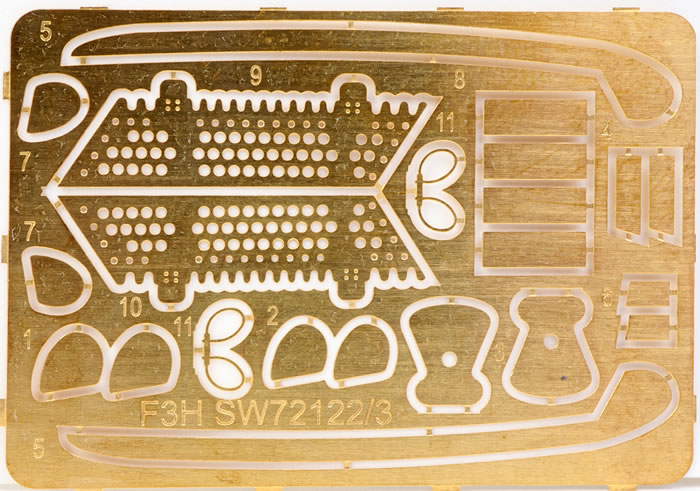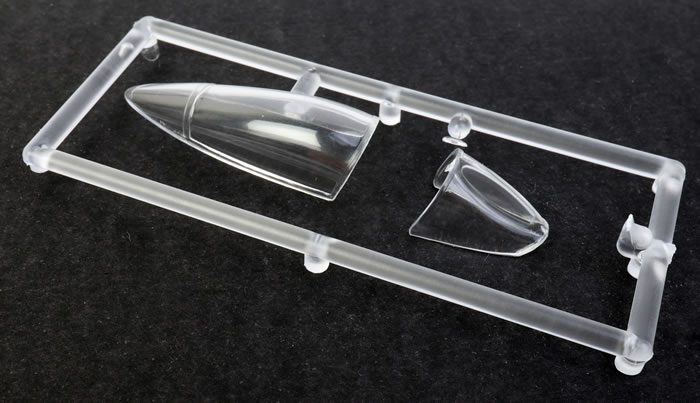|
F-3B/C Demon

Sword, 1/72 scale
S
u m m a r y |
| Description and Catalogue Number: |
Sword Kit No. 72140 - F-3B/C Demon |
| Scale: |
1/72 |
| Contents and Media: |
See details below. |
| Price: |
€14.78 plus shipping available online from Sword
GBP£17.99 EU Price (£14.99 Export Price) plus shipping available online from Hannants
and hobby retailers worldwide |
| Review Type: |
FirstLook |
| Advantages: |
Nicely moulded with high level of detail; nice use of photo-etch and resin; great set of decals.. |
| Disadvantages: |
None noted apart from the usual caveat about parts with no location pins. |
| Conclusion: |
This is a splendid kit of quite a big early USN jet fighter and one that should be welcomed by modellers who missed it the first times around. Great use of different materials to enhance the final product. Recommend to the US Naval modeller. |
Reviewed by Graham Carter

The McDonnell Demon F3H was not a great success, not so much because of the design but due the inadequacies and technical issues with the engines that were available in the day, that being the Westinghouse J40 (should have stuck to washing machines!).
Designed in 1949 as a single engined carrier-based fighter it was ordered off the drawing board in 1951 but was not available until 1953. Even then the problems with the J40 meant its cancellation, and the fitting of Allison J71, which in turn had its share of problems, the Demon entering service in 1956 replacing the Banshee, and being withdrawn in 1964, after a bit over 510 were produced.

The confusing, for me anyway, designations of F-3B/C refer to the renumbering of the F3H-2N which became the F-3C, the F3H-2M became MF-3B and the F3H-2 changed to F3-B, in 1962 - so now you know!! The Demon was a key step in the design of the far more capable Phantom, to whose overall appearance it is generally similar.
The only 1/72 scale kit before this one was the Emhar one from the early 1990s, a reasonable kit for its time but lacking a lot of finesse.
Sword's new Demon surpasses that one and was released in 2019 as the F3H-2/F-3B (SW72122) and F3B/F3H-2N (SW72123).
Pavla produces a number of enhancement kits for the kits in resin, and Airwaves did a photo-etched set in the 1990s for the Emhar kit.
This is the third iteration of Sword's Demon and marks another step in their policy of reissuing kits with minor tweaks and new decals. I have not seen the earlier kits so assume this one just has different decal choices.
I must admit that I was sceptical that a plane as big as the Demon could be fitted in the standard Sword box but it does by dint of the fuselage being split behind the cockpit.
The box is of the end-opening type with a nice CAD drawing on the top and the two decal choices illustrated on the bottom. The kits parts certainly fill the box and come in a zip-lock bag. Parts fill two large mid-grey sprues and there is a small one with number of triangular fins on it that is not mentioned anywhere in the instructions or parts map so I have no idea what they are for - the missiles provided all have their full complement of fins.

Also included are a photo-etched fret, transparencies and a set of resin for two alternate seat designs and the exhaust ring.
All parts are well moulded, with consistent fine lines and details, although again some modellers might like to see the control surfaces given more definition as they are engraved to the same depth as panel lines.
Surface textures are really nicely done.
As usual with short run mouldings, there are no locating pins or holes so take care in joining major components.
The photo-etched fret provides such items as the ejection seat handle, eight wing fences, air brakes and a few panels and the moveable tailplane plates, and are well etched.

As well as the alternate resin seats, there are also different tail cones and weapon fits. A pretty complete package.

The windscreen and sliding canopy section are separate parts so the cockpit can be displayed easily.

The instructions fill twelve pages of an A5 booklet that includes a parts map, colour chart (by name only - no manufacturer suggestions), 24 construction steps and two four-view coloured markings diagrams.
No indication is given as to which seat variation goes with which aircraft although the tail shape and speed brake situations are clearly matched to the different decal variant.
Detail colours are noted at each stage with a paint-drop letter. The weapon choice of Sparrows or Sidewinders is clearly marked and only the VF-213 choice has the refuelling probe fitted.
With a full load of tanks and missiles this would be a mean-looking machine and not have been particularly agile given the single engine.
Markings
Decals are beautifully produced in gloss finish with great colour density and register, and minimal carrier film. Printed on blue backing sheet they are easy to pick out and include only a small number of panel stencils.

The two choices are both in Light Gull Gray over white and are:
-
F-3B Demon of VF-213, USS Hancock in mid 1963, the modeller will have to paint the fin top blue for the decal stars there, and
-
F-3B/C Demon of VF-14 on USS Forestal , late 1956, with decals for the red fin and wing-tip stripes although I suspect it would be easier to paint these.
This is a splendid kit of quite a big early USN jet fighter and one that should be welcomed by modellers who missed it the first times around. Well done Sword!
Thanks to Sword Models for the review samples.
Text and Images Copyright © 2021 by Graham Carter
Page Created 25 November, 2021
Last updated
25 November, 2021
Back to HyperScale Main Page |
